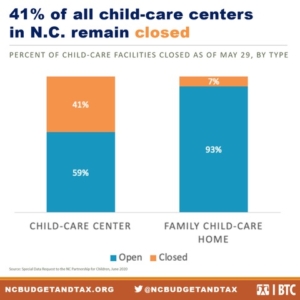When the COVID-19 pandemic hit, many of our child care facilities closed their doors with no guarantee they would be able to reopen when the time came for parents to go back to work.
In North Carolina, 43 percent of all child care centers were closed on April 14, and 41 percent were closed as of May 15. That is nearly half of the facilities in a state where 99 of 100 counties are already child care deserts for infants and toddlers. Many center directors have reported concerns about their abilities to financially withstand a lengthy closure. If these concerns are realized, the state could potentially lose 753 child care centers.

Without access to quality child care, working parents cannot get back to work, hindering the rebuilding of our economy. In the coming weeks, the North Carolina Early Childhood Foundation will be surveying parents to better understand the data around parental preference for child care in the context of COVID.
One type of care that has been increasing before COVID-19 is in-home or home-based care, when a caregiver looks after children in their own home, sometimes with the help of an assistant. This model is growing in popularity as it provides flexibility and affordability to parents who have to go back to work, along with early morning care or night-shift care for parents who work outside a 9-5 day shift. Choosing licensed, quality child care is essential to the safety and healthy development of young children.
Potential benefits to working parents
One potential advantage to in-home care is the cost savings. On average, families spend $596 a week on nannies and $213 a week on child care centers, while in-home care is typically $199 a week.
Children with home-based caregivers are also likely to spend their days with a smaller group of children. As we continue fighting the spread of COVID-19, keeping kids in smaller, more consistent groups has been recommended by the CDC to help slow virus transmission.
As we transition older children back to school, there is a good chance we will see staggered scheduling. Some children may only go to school for a few hours. Some may only go certain days of the week. In-home care typically caters to a wider age group, making it flexible enough to take in students on days they won’t be physically going to school. It also helps siblings stay together for easier parent pick-up and drop-off.
How employers can help working parents
No matter what type of child care employees turn to, there are policies NC businesses can put in place to help the transition back to work easier for families.
Flexible work – Telecommuting allows employees to work from home or a remote site for some or all of the time. This is the life most of us have been living these days, but continuing this policy could improve your employee satisfaction, retention, and productivity.
Backup or emergency child care – Licensed child care programs offered at an employer’s work site or in centers, or in an employee’s home helps employees continue work despite disruptions in normal caregiving arrangements, and employers have the power to negotiate rates with local care centers. Offering a backup plan gives working parents peace of mind and increases your business’ overall productivity and improves recruitment.
Subsidized/reimbursed child care – Employers can reimburse or subsidize all or part of an employee’s approved child care costs. They may also reserve slots at particular facilities for employees’ children. By implementing this policy, you offer much-needed resources to parents looking for quality child care in the area. In turn, your business will see increased retention, lower turnover costs, and reduced employee absenteeism.
Paid parental leave – This is leave provided for those employees who have given birth, adopted, or accepted a foster placement of a child. This is separate from vacation time or sick leave. Not only does a paid parental leave policy increase morale and job satisfaction, it also improves recruitment and retention.
Predictable scheduling – Allows employees to have input into their work schedule, provides at least two weeks’ notice of work schedule and discourages last-minute schedule shifts so parents can more reliably plan for care needs and secure high-quality care.